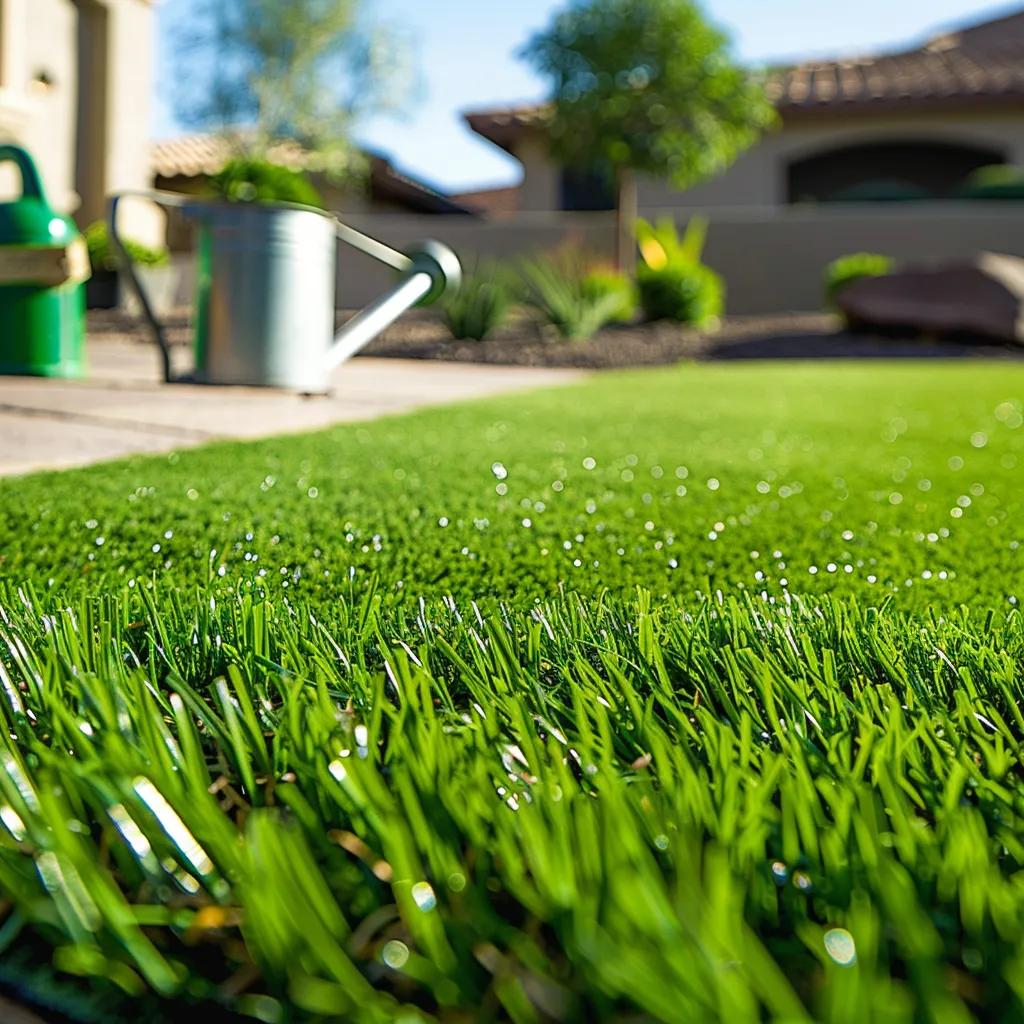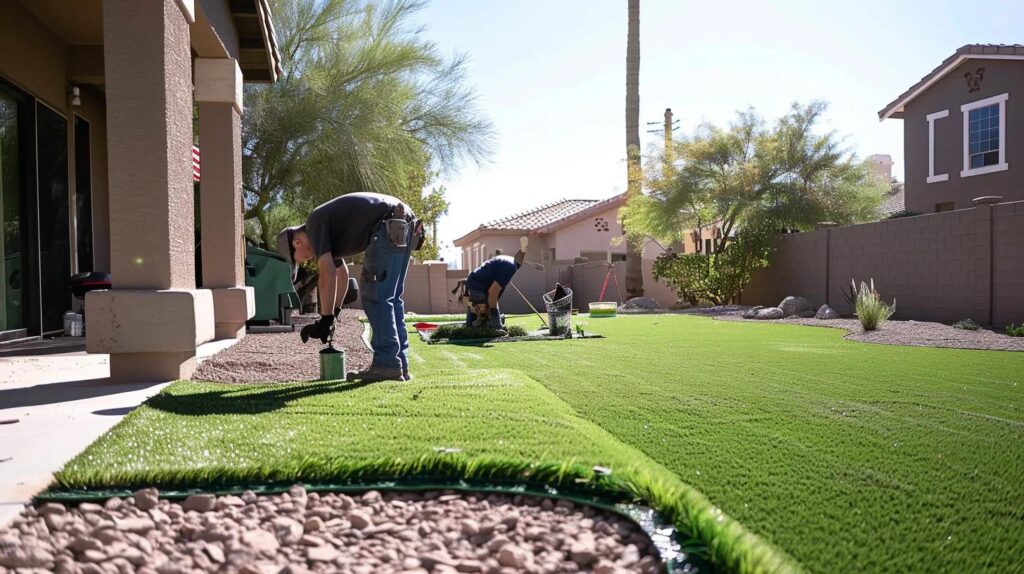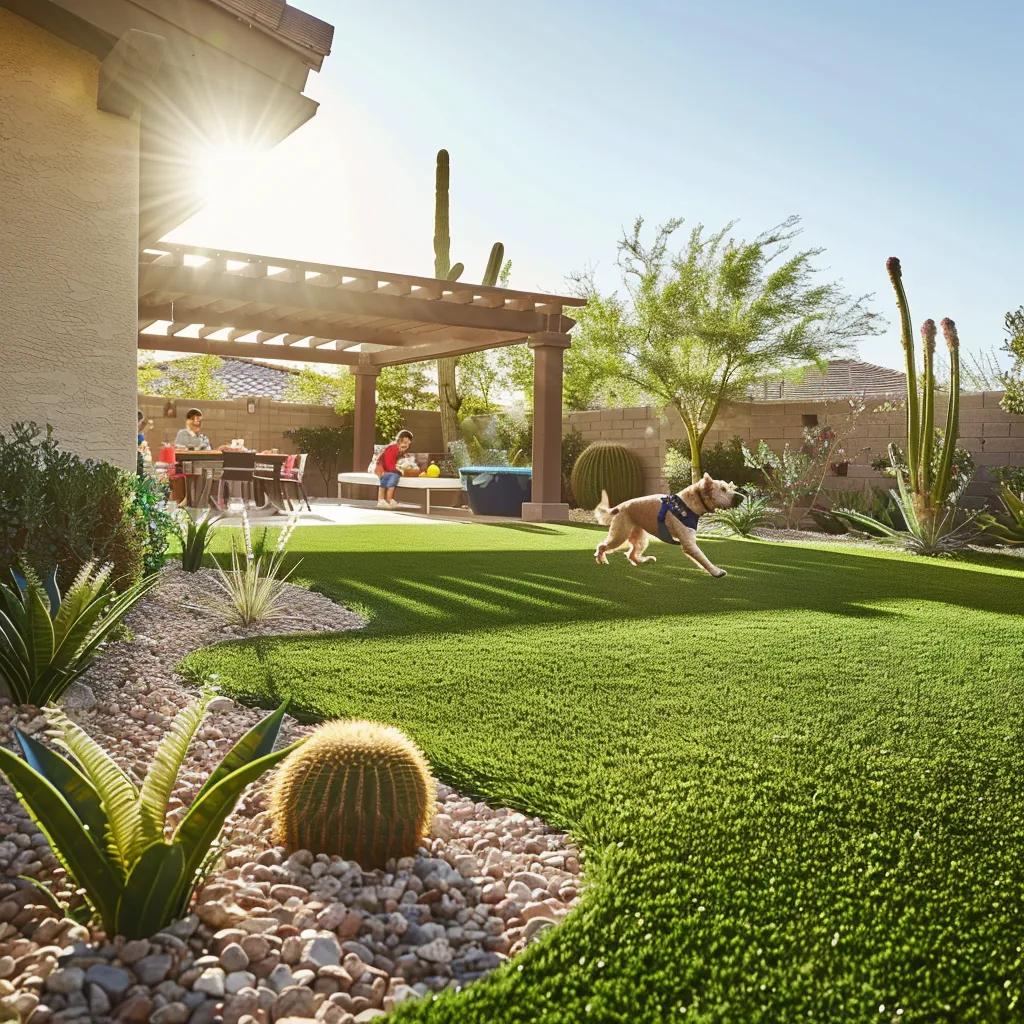Artificial Turf Installation in Phoenix — Local Experts for Your Dream Lawn with High End Outdoor Services
Artificial turf gives Phoenix homeowners a dependable way to keep a green, low‑maintenance yard through the desert heat while cutting water use and ongoing lawn expenses. This guide walks through how artificial grass installation works in Phoenix, compares turf types suited to Arizona conditions, outlines the installation steps, and highlights common cost drivers and expected ROI. You’ll get practical benefits—water savings, pet‑friendly options, UV protection—and a look at how local turf installers handle design, drainage, and long‑term care. The article covers four main areas: why hire a local installer, advantages in a desert climate, the installation workflow, and cost versus return on investment. Throughout, we reference local expertise and services from High End Outdoor Services (HEOS) to help homeowners, HOAs, and property managers evaluate professional turf installation in Greater Phoenix.
Why Choose High End Outdoor Services for Artificial Turf Installation in Phoenix?
High End Outdoor Services (HEOS) brings neighborhood knowledge to every turf project, matching product choices and landscape details to Phoenix’s climate. We prioritize craftsmanship, selecting materials with strong UV protection and proper drainage to limit heat retention and keep turf performing season after season. HEOS works with homeowners, HOAs, property managers, and commercial clients across Scottsdale and Greater Phoenix, coordinating hardscaping and ongoing maintenance when needed. For anyone looking for a reliable local partner, HEOS delivers custom design and practical durability.
What Makes HEOS the Best Artificial Turf Installer in Arizona?
HEOS is family‑owned and based in Scottsdale, combining landscape design, turf installation, and maintenance into cohesive projects. Our services include Artificial Grass Installation, Turf Installation, Landscape Design, Landscape Maintenance, Hardscape, Commercial Landscaping, HOA Landscape Maintenance, Hospital and Medical Facility Landscape Maintenance, and Community Landscape Maintenance—so we can manage complex site integration from start to finish. Carl Gille is the point person for estimates and project planning, reinforcing local accountability. This mix of services ensures smooth transitions from design through long‑term care for every client.
How Does HEOS Ensure Quality and Durability in Turf Installation?
We select synthetic turf with an emphasis on UV resistance, robust backing, and pile heights and face weights matched to each use. Our installation standards focus on correct base preparation, effective drainage layers, and infill choices that limit heat buildup and extend turf life. After installation we perform quality checks and a maintenance handoff so clients understand care routines that protect warranties and their investment. These material and process choices reduce common failure points and deliver a longer‑lasting, attractive lawn.
Effects of UV Degradation on Synthetic Turf Properties
Synthetic turf is designed for outdoor use and is therefore vulnerable to ultraviolet (UV) degradation from UVA, UVB, or a combination of both. Because most turf fibers are polyethylene, UV exposure can break molecular bonds, leading to cracking and reduced performance, plus color changes over time. Manufacturers add UV stabilizers to slow this process, but effectiveness varies with the specific UV bands involved. Field testing under natural sunlight is a key part of evaluating long‑term durability.
The effects of natural and artificial UV exposure on the physical properties of synthetic turf used for various sports fields, 2014
What Are the Benefits of Artificial Turf Installation in Phoenix’s Desert Climate?

Artificial turf cuts outdoor water use and maintenance time while delivering consistent, year‑round curb appeal in arid climates. Turf replaces regular lawn watering, reduces mowing and chemical treatments, and—when you choose UV‑protected products—stands up to strong sun. These advantages make synthetic turf especially useful for homeowners and property managers who want resilience and predictable costs in Phoenix. The result is a durable landscape solution that supports water conservation and modern desert design.
Before the comparison table, here are the main practical benefits to consider.
- Water Savings: Removes the need for routine irrigation on lawn areas, conserving municipal and well water.
- Low Maintenance: Eliminates mowing, reduces fertilizer use, and cuts many pest treatments from regular chores.
- Durability: UV‑protected fibers and quality backing resist color fade and wear even under heavy foot traffic.
These points help property owners lower operating costs and simplify upkeep, and they lead naturally into how different turf types meet specific needs.
| Benefit Area | How It Helps Phoenix Lawns | Practical Result |
|---|---|---|
| Water Use | Removes regular irrigation requirement | Significant reduction in household irrigation volume |
| Maintenance Time | No mowing, less chemical use | Lower recurring labor and supply costs |
| Durability | UV-protected fibers, proper backing | Longer lifespan under desert sun |
This comparison explains why many local installers recommend synthetic turf as a drought‑resistant landscaping choice.
How Does Artificial Grass Save Water and Reduce Maintenance?
Artificial grass saves water mainly by replacing thirsty turf areas with a surface that only needs occasional rinsing. Maintenance shifts from weekly lawn chores to periodic debris removal, sanitation in pet zones, and infill grooming to keep fibers upright. Homeowners typically swap hours of mowing for quick seasonal checks and targeted repairs, lowering annual upkeep costs and shrinking the environmental footprint of traditional lawn care in water‑stressed regions.
Is Artificial Turf Safe and Pet-Friendly for Arizona Homes?
Pet‑friendly turf options feature antimicrobial infill, fast‑draining layers, and durable backing that resist lingering odors. Choosing non‑toxic, lead‑free materials and specifying high drainage rates lowers runoff and keeps pet areas hygienic with simple rinsing. Regular maintenance—spot cleaning, infill top‑ups, and occasional sanitizing—keeps surfaces safe for kids and pets. These steps let families enjoy the convenience of synthetic turf without sacrificing cleanliness or safety.
| Turf Type | Key Specs (pile height, face weight, infill) | Best Use |
|---|---|---|
| Residential Turf | 30–40mm pile; medium face weight; sand infill | Lawns, family yards |
| Pet Turf | 20–30mm pile; heavier backing; antimicrobial infill | Dog runs, pet play areas |
| Putting Green Turf | 10–14mm pile; dense face weight; minimal infill | Backyard greens, practice areas |
This quick reference helps homeowners match turf specs to yard use and maintenance expectations.
How Does the Artificial Turf Installation Process Work with HEOS?

Our installation follows clear stages: consultation, design, material selection, site prep, drainage planning, installation, and final inspection. HEOS emphasizes integrated landscape design so turf works with hardscapes, irrigation reductions, and maintenance plans. Project timelines include grading, base compaction, and curing for long‑term stability. When you’re ready to move forward, HEOS supports every phase with a focus on durable results and homeowner education.
What Are the Key Steps in HEOS’s Turf Installation Methodology?
- Site Assessment: Measure the area, photograph conditions, and document existing features.
- Design & Material Selection: Recommend turf types and complementary hardscape elements.
- Base Prep & Drainage: Grade and compact the base to ensure stability and proper runoff.
- Installation & Inspection: Lay turf, add infill, and perform final quality checks before handoff.
These steps provide transparency and set clear expectations for timelines and outcomes before construction begins.
Which Materials and Turf Types Are Best for Phoenix Lawns?
Picking the right turf balances UV protection, drainage rate, and pile height for the intended use and sun exposure. Residential yards do well with mid‑height pile and moderate infill for comfort and resilience; pet areas need rapid drainage and antimicrobial infill. Commercial and HOA projects typically require higher face weight and reinforced backing to withstand heavy traffic. Warranty terms and expected product life in intense sun should guide your selection.
| Turf Type | Key Specs (pile height, face weight, infill) | Best Use |
|---|---|---|
| Residential Artificial Turf | 30–40mm pile; medium face weight; sand or hybrid infill | Everyday yards |
| Pet-Specific Synthetic Turf | 20–30mm pile; robust backing; antimicrobial infill | Dog areas |
| Commercial/HOA Turf | 30–50mm pile; high face weight; premium infill | High-traffic landscapes |
This table clarifies material choices tailored for Scottsdale and the Greater Phoenix climate.
How Much Does Artificial Turf Installation Cost in Phoenix and What Is the ROI?
Cost is driven mainly by square footage, site‑prep complexity, drainage needs, and turf quality. Higher‑spec products and extensive grading or hardscape integration raise upfront costs but can extend longevity and lower lifecycle maintenance. ROI typically shows up as lower water bills, no mowing service, and reduced chemical and labor expenses over time. For an accurate price and ROI estimate, request a site‑specific proposal that reflects local conditions.
What Factors Influence the Cost of Synthetic Grass Installation?
Several predictable factors explain price differences between bids and affect long‑term ROI. Site access, slope correction, and removal of existing materials increase labor and equipment needs. Turf grade, warranty length, and recommended infill change material costs. Integrating hardscape or converting irrigation amplifies scope and budget but can boost property value and long‑term savings.
- Site Prep: Grading and removal increase labor and disposal costs.
- Turf Quality: Higher face weight and UV protection cost more up front.
- Drainage & Integration: Added drainage or hardscape raises complexity.
Knowing these drivers helps homeowners manage costs without sacrificing performance.
Thermal Performance of Artificial Turf in Urban Settings
Research shows artificial turf can reach high surface temperatures in summer, which affects usability and comfort during peak heat. Proper product selection, infill choice, and installation details can influence thermal performance on site.
Modeling the thermal effects of artificial turf on the urban environment, N Yaghoobian, 2009
| Cost Factor | Description | Impact on Price/ROI |
|---|---|---|
| Site Preparation | Grading, removal, compaction | High: affects labor and materials |
| Turf Quality | Fiber type, backing, UV rating | Medium-High: affects lifespan |
| Drainage Systems | Perforated layers, slope correction | Medium: reduces future repairs |
This breakdown shows where investing up front yields better durability and lower maintenance later.
How Does Artificial Turf Increase Property Value and Save Money?
Synthetic turf cuts recurring landscape costs—water, mowing, and treatments—while boosting curb appeal with a consistent, green look. Lower utility and service bills create measurable annual savings that accumulate into a positive ROI over several years compared with natural turf. For a professional result and an accurate ROI estimate, contact HEOS for a custom proposal—precise numbers depend on site specifics and product choices.
Generate leads for landscape design, installation, and maintenance services.

